Today we feature Joe Manganelli, Founder & CEO of Calculate. Joe manages Calculate’s own books in Quickbooks Online, and uses their invoicing functionality to send and collect invoices from Calculate’s customers. We’ll cover how Joe used Amalgam to cut many hours and errors from this monthly invoicing process.
Check out our templates center for a version of this solution that you can download and try out for your own business.
The Problem
Joe and team use Toggl for timekeeping. Toggl provides users with helpful features like a Chrome Plugin and calendar syncing, but it doesn’t connect nicely with Quickbooks when it comes time to turn hours into invoices each month.
Furthermore, Calculate bills its clients in a unique, nuanced way that would still require many hours of data prep before Joe could hit send. “Our invoicing process is quite detailed and unique every month, which requires a lot of manual effort. We have about 90 separate invoices with several hundred total lines,” Joe said of the challenge.
Joe had experimented with other invoicing platforms in the past, but found that even though some parts could be automated, he didn’t have enough control over the output. There was no point generating 90 invoices that were almost correct. He’d still have to make manual checks and changes, which took just as long. So he mostly stuck to using the “copy invoice” function in Quickbooks.
The Solution
Joe had three main data sources:
- Time tracking data, exported from Toggl each month
- Contract data, with the rates or retainer amounts for each client
- Quickbooks Invoices, to be created from 1 and 2
He was already keeping this information organized simply to manage Calculate’s books each month. All he had to do was add Amalgam to a spreadsheet that already existed. “We integrated our raw data file (timesheet data) and added the invoice loader function to create our invoices.” That alone saved 4 or 5 hours of data entry each month.
“Each tab of our invoicing master file contains that month’s timesheet data. That data is amalgamated into a form to fit the invoice upload template. After the normal checks are performed, that template is loaded to QBO to create those invoices. Once in QBO, they can be sent in a batch. If any errors are created in the dataset, they are easily fixed from our master file and the invoice loader template.”
As an editorial note, Joe used the word “amalgamated” on his own…
The Impact
Joe estimates 4-5 hours in time savings each month; those are weekend hours that would otherwise have been spent typing numbers into a Quickbooks Online interface. Those are high value hours not just as a CEO, but as a human being!
Beyond the simple time savings, Joe is able to get invoices out to customers in a more timely fashion, which is crucial to keeping AR in check and keeping the business healthy from a cash perspective, arguably Joe’s most important job.
And as the team grows, Joe also spends less time managing (and chasing down) timesheets. Unfinished timesheets can easily put a drag on both revenue and administrative hours, but with this solution, Calculate can easily check for missing hours, employee by employee, in only a few seconds before invoices get loaded up.
Calculate helps startups and growing businesses with the numbers side of their business. To get in touch with Joe or discuss working with Calculate, contact [email protected].




